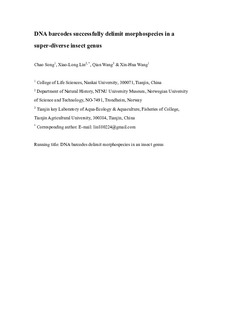DNA barcodes successfully delimit morphospecies in a superdiverse insect genus
| dc.contributor.author | Song, Chao | |
| dc.contributor.author | Lin, Xiaolong | |
| dc.contributor.author | Wang, Qian | |
| dc.contributor.author | Wang, Xin-hua | |
| dc.date.accessioned | 2019-02-19T13:47:48Z | |
| dc.date.available | 2019-02-19T13:47:48Z | |
| dc.date.created | 2018-11-20T11:33:55Z | |
| dc.date.issued | 2018 | |
| dc.identifier.citation | Zoologica Scripta. 2018, 47 (3), 311-324. | nb_NO |
| dc.identifier.issn | 0300-3256 | |
| dc.identifier.uri | http://hdl.handle.net/11250/2586326 | |
| dc.description.abstract | Polypedilum Kieffer (Diptera: Chironomidae), with 520 currently known species worldwide, can be extremely difficult to identify species level based on the morphology. We used 3,670 cytochrome c oxidase subunit I (COI) barcodes to explore the efficiency of the COI barcodes to differentiate between species in a superdiverse aquatic insect genus. The Barcode of Life Data System (BOLD) presented 286 BIN clusters in Polypedilum, representing 163 morphospecies, of which 93 were contributed from our laboratory. Molecular operational taxonomic units (OTUs) ranged from 158 to 345, based on Automatic Barcode Gap Discovery (ABGD), the Barcode Index Number (BIN), Bayesian Poisson tree processes (bPTP), generalized mixed Yule coalescent (GMYC), jMOTU, multi‐rate Poisson tree processes (mPTP), neighbor‐joining (NJ) tree and prethreshold clustering. In comparison, GMYC, bPTP, mPTP and BIN suggested more species than warranted by morphology, while ABGD, jMOTU, NJ, prethreshold clustering and ABGD yielded a conservative number of species when setting higher thresholds. Nine species complexes with deep intraspecific divergences indicated 18 potentially cryptic species, which require further taxonomic research including complete life histories and nuclear genetic data to be resolved. The discrimination of Polypedilum species by DNA barcodes proved to be successful in 94.4% of all studied morphological species. | nb_NO |
| dc.language.iso | eng | nb_NO |
| dc.publisher | Wiley | nb_NO |
| dc.title | DNA barcodes successfully delimit morphospecies in a superdiverse insect genus | nb_NO |
| dc.type | Journal article | nb_NO |
| dc.type | Peer reviewed | nb_NO |
| dc.description.version | acceptedVersion | nb_NO |
| dc.source.pagenumber | 311-324 | nb_NO |
| dc.source.volume | 47 | nb_NO |
| dc.source.journal | Zoologica Scripta | nb_NO |
| dc.source.issue | 3 | nb_NO |
| dc.identifier.doi | 10.1111/zsc.12284 | |
| dc.identifier.cristin | 1632554 | |
| dc.description.localcode | Locked until 30.03.2019 due to copyright restrictions. This is the peer reviewed version of an article, which has been published in final form at https://doi.org/10.1111/zsc.12284. This article may be used for non-commercial purposes in accordance with Wiley Terms and Conditions for Self-Archiving. | nb_NO |
| cristin.unitcode | 194,31,10,0 | |
| cristin.unitname | Institutt for naturhistorie | |
| cristin.ispublished | true | |
| cristin.fulltext | postprint | |
| cristin.qualitycode | 1 |
Tilhørende fil(er)
Denne innførselen finnes i følgende samling(er)
-
Institutt for naturhistorie [1240]
-
Publikasjoner fra CRIStin - NTNU [38294]
